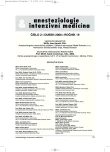The theory and simplified mathematical model of multi-level intermittent positive pressure ventilation
Authors:
Török Pavol
Authors‘ workplace:
OAIM, Vranovská nemocnica n. o., Vranov nad Topľou, Slovenská republika
Published in:
Anest. intenziv. Med., 19, 2008, č. 2, s. 96-104
Category:
Intensive Care Medicine - Original Paper
Overview
Objective:
Considering the issues of intermittent positive pressure ventilation (IPPV) in non-homogenous pathological lung processes, the author built a mathematical model of tri-compartment non-homogenously injured lungs ventilated with a new mode of IPPV – multi-level ventilation. The author defines multi-level ventilation as a type (modification) of IPPV consisting of background ventilation using the CMV, PCV or PS (ASB) ventilation mode and an added level called “on-background ventilation“ consisting of multiple levels of PEEPh (PEEP high) with variable frequency and duration of transition between individual levels of PEEP.
The objective was to prove whether in cases of considerably non-homogenous gas distribution in acute pathological disorders of the lungs it is possible to improve gas distribution into slow broncho-alveolar compartments while only minimally or not at all increasing the volume load of the fast compartments by using the multi-level IPPV.
Setting:
Department of Anaesthesiology and Intensive Care Unit.
Materials and methods:
Multi-level ventilation on three pressure levels was carried out by a mathematical model as a combination of pressure-controlled ventilation (PCV) and two levels of PEEP: PEEP (constant) and PEEPh (PEEP high).
Results:
Comparing single-level IPPV in the PCV mode with the tri-level ventilation (PCV+PEEPh/PEEP), the author found that the loading of the slow compartments in the model was considerably improved by as much as 50–60% in comparison to the baseline value. This difference, in absolute figures, reached as much as a 2–10 times increase in volume, or a 1.2–3 times increase in minute ventilation in compartments k4 and k5.
Conclusions:
The mathematical model proves that the application of multi-level IPPV can achieve considerable changes in gas distribution in the lung parenchyma affected by a non-homogenous pathological process. The mathematical model requires further verification in the clinical setting to answer questions regarding its efficacy.
Keywords:
IPPV – multi-level ALV – ARDS – ALI
Sources
1. Gattinoni, L. et al. Lung structure and function in different stages of severe ARDS. J. Am. Med. Assoc., 1994, 271, p. 1772–1779.
2. Májek, M., Krajčiová, K., Török, P. Akútne ventilačné a respiračné zlyhávanie. Lekársky obzor, 1997, 46, č. 9, s. 219–223.
3. Török, P. et al. Optimalizácia UVP počas anestézie. In Priebežná správa o riešení výskumnej úlohy MZ SR č. 49/97 za r. 1998. 68 s.
4. Török, P., Májek, M., Kolník, J. Je časová konštanta Tau (τ) pri umelej ventilácii pľúc konštantou? Teoretický a fyzikálny model. Anest. neodklad. Péče, 2001, 12, č. 6, s. 291–297.
5. Török, P. Multilevel ventilation. In Zborník z konferencie Ruskej akadémie vied – Akútne zlyhanie pľúc. Piešťany-Moskva, 30. 9.–3. 10. 2006, 187 s.
6. West, J. B. Bioengineering Aspects of the Lung. Marcel Dekker, inc. : New York 1977, 585 s.
Labels
Anaesthesiology, Resuscitation and Inten Intensive Care MedicineArticle was published in
Anaesthesiology and Intensive Care Medicine

2008 Issue 2
Most read in this issue
- Epidemiology of invasive candidiasis and candidemia – a persistent problem
- Tri-level pulmonary ventilation (3LV®) – initial clinical experience
- LMA-ProSeal™ laryngeal mask is a safe option for securing the airways for laparoscopic cholecystectomy
- Dexmedetomidine-ketamine intravenous sedation during local anaesthesia
